Earth Overshoot: Humans Are Cornering Themselves Faster Than Predicted
Ask the reindeer.

Everyone is bombarded these days with "prepare now," but no one really discusses why. Boy, do I have an article for you today, backed by data.
For the past fifty years or more, our global civilization has been on the verge of collapse. That is the approximate time at which the human population overshot, a concept that is essential to understand in order to make sense of what we're doing to the earth and how much trouble we're in.
What is Overshoot?
When a species' needs surpass the ecosystem's potential for regeneration, ecological overshoot occurs. The population of the species explodes as it grows and eats the ecosystem at an ever-increasing rate. The population then plummets when there is no more resources left to sustain itself.
This is our current problem. The fear of nuclear war, biodiversity loss, and climate change are the most commonly discussed issues facing the globe today, but these issues are only symptoms of ecological overshoot. Let's examine a well-known and documented instance of ecological overshoot that happened on an island off the coast of Alaska to better understand.
The Reindeer Herd of St. Matthew Island
Located in the middle of the Bering Sea on 128 square miles of tundra, St. Matthew Island is more than 200 miles away from the closest community in Alaska. It is said to be Alaska's most isolated location.
Before the Second World War, it was vacant. The Coast Guard then stationed 19 men on the island to run the station in 1944 after installing a loran (far-range navigational aid). To ensure the men had a contingency supply of food, the Coast Guard brought 29 reindeer onto the island.
It was heaven for the reindeer. There were no predators, grass all around, and lichen, which is like candy to reindeer, covering the tree trunks. Eventually the men were removed from the island, and the reindeer were left behind as World War II was coming to an end. In the next ten years, they procreated like bunnies.
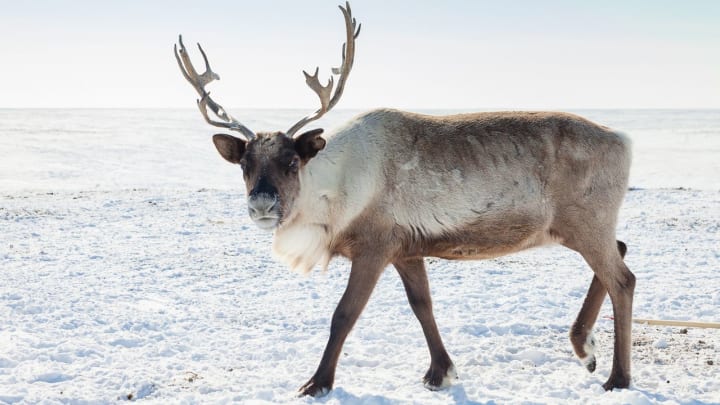
The Fish and Wildlife Service paid biologist Dave Klein of the U.S. Department Of Fish and Game to visit St. Matthew Island in 1957, thirteen years later. About 1,350 reindeer were counted, and they all looked to be quite fat and well-fed. The island's lichen mats, which were several inches thick, provided a plenty of food, causing the number of reindeer to increase significantly.
Klein and the other three scientists made a second trip to the island in 1963. They counted 6,000 reindeer this time. But the deer didn't seem to be as robust and plump as they had been, and there were indications of overgrazing on the area.
When he went back in 1966, he discovered a horrifying scene. There were only forty-two emaciated deer left alive, and the island was covered in deer skeletons. This indicates that in a matter of years, the population had fallen by 99%.
What then caused this? Why did the number of reindeer on the island not increase to its carrying capacity before leveling off?
The answer: Overshoot.
The majority of people would presume that if an island had 6,000 deer, there had to be a carrying capacity of at least 6,000. The carrying capacity was likely closer to 1,000 or 2,000 in actuality. The surrounding vegetation was unable to keep up with the rapid growth of the deer population.
Global Population Size During the Past 12,000 Years
Because they lived as hunter-gatherers before 10,000 BCE, the temperature back then fluctuated greatly, rising and falling by several degrees Celsius over the course of a millennium.
Subsequently, an extraordinary phenomenon occurred: the Earth's climate became exceptionally stable, with the average global temperature remaining within a range of less than 1 degree Celsius for the following 12,000 years, until the 20th century. We refer to this period as the Holocene.
The weather became considerably more predictable. People could now anticipate roughly the same amount of rainfall year rather than patches of drought and flooding happening every few years, and start to grow food instead of going out to forage. This made it possible for crops to grow quickly right at home, thus raising the carrying capacity of inhabitants in the area.
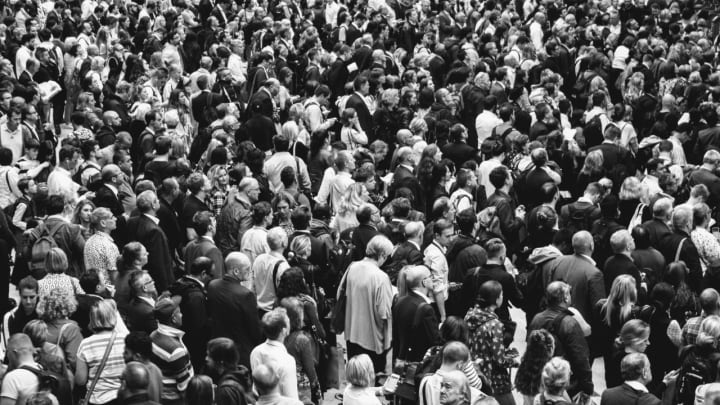
The human population started to increase gradually by around 0.04% year, and by the 1700s, the rate of growth was starting to exponentially increase. With the development of new technologies like the steam engine and the water frame, humans were able to create more commodities. More innovations, such incandescent lighting and electric generators, appeared by the 1800s.
The most essential thing about these inventions is that they allowed people to capture more energy. The population grew even quicker as people's level of living increased and they were able to have more children, because simply, they were able to feed them.
The main energy sources were coal, wood, and whale oil until the late 1800s. However, everything changed when oil resources were discovered in America in the early 1900s. Oil had double the energy density of coal and was far more flexible and adaptive. Not to mention, pulling it out of the ground was lot simpler.
Populations and living standards increased even more quickly with all of this additional energy. All of a sudden, people were creating radios, TVs, cars, and airplanes. There appeared to be an endless supply of energy.
From only 3.5 billion back then to over 8 billion today, the population has certainly grown.
The 1970's marked the start of the green revolution. New chemical fertilizers like phosphorous and ammonia, which come from natural gas, as well as agrochemicals like insecticides and herbicides, which come from oil, were used by farmers. They also started using new kinds of farming machinery that automated harvesting and cultivation.
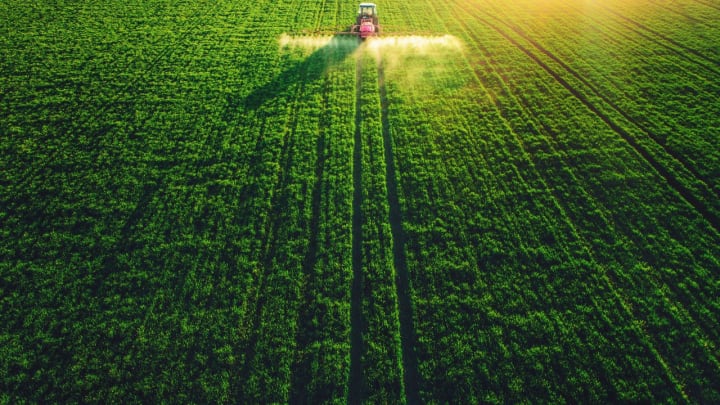
That's not all, though. A drought used to result in a considerably lower agricultural production, but modern technology has made it possible for farmers to draw water from subterranean aquifers. Additionally, new high-yield crop kinds that were never found in nature were created by scientists.
Overextend and Break
Because of all these new energy sources and technological advancements, mankind has significantly expanded the planet's carrying capacity. It comes with a price though.
Oil and natural gas are examples of fossil fuels that are absolutely necessary for us to feed the world's 8 billion inhabitants. They will get very expensive if we start running out, which implies everything else will get very expensive too, especially food. Sound familiar?
Peak Petroleum
Peak oil is the point at which there is a drop in oil production—or, more accurately, extraction from the earth. Peak oil will eventually occur since the amount of oil on the globe is limited. It's not a question of if, but when.
Yes, oil companies are still finding new oil fields, but not quickly enough to meet demand. The number of fresh oil finds is actually at its lowest point in 75 years. We are in serious trouble if peak oil has indeed been reached. Population increase and energy use are directly correlated.
Global Population and Energy Consumption
Some claim that because we are converting to new technologies like solar panels, wind turbines, and electric vehicles, we don't need to worry about peak oil. But we still need fossil fuels to produce so-called renewables, such as the plastic in them, since the transition isn't happening quickly enough.
Furthermore, rare-earth metals—another limited resource—are needed for all this renewable energy. Oil has the advantage of having all of its energy already stored within it. However, in order to use renewable energy sources to power our houses and cars during periods when the sun and wind aren't present, like solar power, the energy must be stored in batteries. And guess what? Metals like nickel, cobalt, and lithium are needed to make batteries. The issue is that there may not be enough rare-earth metals in the planet to support a green energy revolution. It's mind-boggling how few people foresaw this issue.
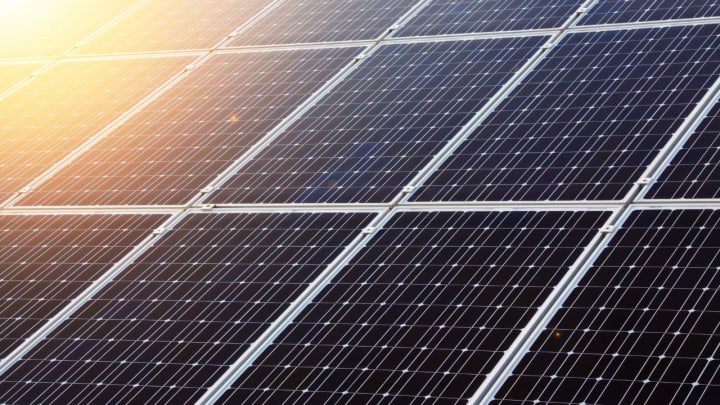
We would still require natural gas to continue growing food on such a massive scale, even in the event that there were enough metals for a green revolution. This can be attributed to the Haber-Bosch mechanism. Thanks to this scientific discovery, we can now extract ammonia from natural gas, which we then utilize to make fertilizer.
Fertilizer made in this manner provides around half of the world's food production. There isn't an alternative yet. This is the reason why the cost of natural gas has skyrocketed, driving up the price of fertilizer and, by extension, food. When we run out, what happens?
It's as though humans have cornered themselves. The population cannot be sustained if we continue to use fossil fuels, which will eventually run out and cause the population to collapse. Yes, we could attempt to utilize less fossil fuels and increase the production of alternative energy, but would just postpone the inevitable?
Human activity has reduced Earth's carrying capacity, much like reindeer reduced St. Matthew Island's carrying capacity. Here are a few signs, hidden in plain sight:
More topsoil is being lost than being replenished. More than 50 billion tons of topsoil have been lost since farmers in the Midwest started tilling the land in the 19th century. The pace of erosion is twice that which is thought to be sustainable. It is predicted by some scientists that the topsoil would disappear entirely in less than 60 years, making it practically impossible to cultivate food the way we do now.
The rate at which aquifers drain outpaces their replenishment. Given that aquifers supply about half of the world's irrigated crops and one-third of the planet's drinking water, this is a bit worrysome.
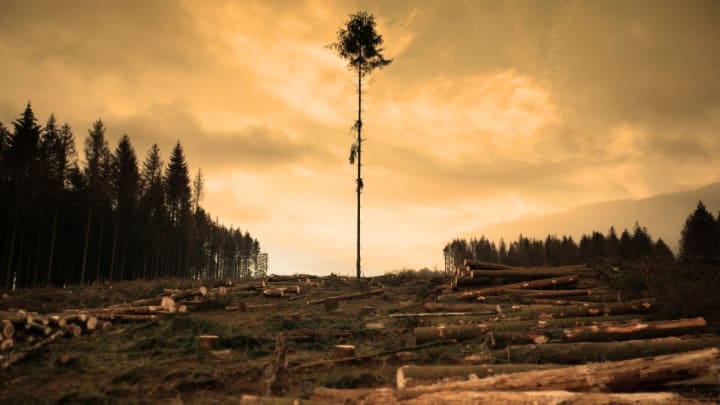
More forests are being destroyed than are being rebuilt. Since trees may grow again, burning them for energy is regarded as renewable in the European Union. But they're burning them quicker than they can regrow. Forests filter the air and water, and we are destroying our life support system.
Fisheries are being depleted more quickly than they can be replenished. 3 billion people have diets that include fish as a major source of protein, as well as the 10% of the global population who depend on fishing for a living.
The extraction of fossil fuels is occurring at a much faster rate than their replenishment. Fossil fuels are a one-time resource for humans because it takes millions of years for sunlight to be stored to create fossil fuel.
Earth Overshoot Day
We now have two major questions that need to be addressed. The first is: Have we yet exceeded Earth's carrying capacity?
An indication of the solution can be obtained by examining studies conducted by the Global Footprint Network. The date on which the planet's natural resources are depleted by human activity is determined annually.
The Overshoot Day for 2023 was August 2nd.
This implies that in order for our civilization to survive after August 2nd, it will have to tap in to resources that aren't being replenished quick enough. Resources such as aquifers, forests, fisheries, fossil fuels, and topsoil.
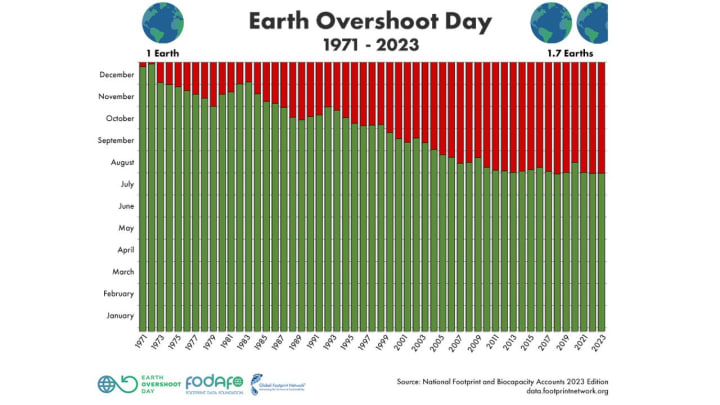
1971–2022 Earth Overshoot Day
We have been in overshoot since 1971, as you can see. more than 50 years prior. Since there were only 3.7 billion people on the earth at the time, it is likely that the true carrying capacity of the planet is less than that number.
SO HOW MUCH TIME DO WE REALLY HAVE?
Collapse and overshoot go hand in hand. Collapse is unavoidable if we have exceeded our planet's carrying capacity. In order to address this, let us examine studies carried out at MIT and released by the Club of Rome in 1972. Their goal was to determine the maximum amount of time that an industrial civilization might exist before running out of basic resources. They examined five elements in order to determine this:
- Manufacturing Productivity/Indrustial
- Pollution Rate
- Resources
- Food
- Population
After obtaining this information, they created the World3 model, a system dynamics model that simulates interactions between these five components using enormous computers to see just how they influence one another.
They experimented with a number of various scenarios. For instance, if we began to live more sustainably, if we discover new methods to expand the planet's capacity for life, and what happens if we do nothing and carry on with things as usual? (Spoiler alert, we carried on business as usual.)
The business-as-usual scenario (BAU2) predicts that civilization would start to collapse about 2040 and that economic growth will peak in the 2030s. This is how it appears:
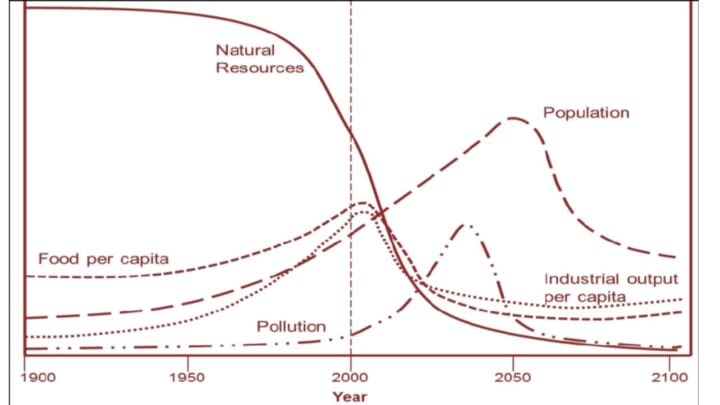
2030.
We may now examine data from the last 50 years to determine the true accuracy of the research, as it was conducted 50 years ago. And that's precisely what Harvard University student Gaya Herrington chose to do.
"Given the unenticing prospect of collapse, I was curious to see which scenarios were most in line with current empirical data," the speaker stated. Given that the book containing this world model was a bestseller in the 1970s, a valid comparison would by now have been made with several decades' worth of empirical evidence. To my astonishment, though, I was unable to locate any current attempts at this. I therefore chose to handle it myself."
In her master's thesis, she examined ten variables:
- Rates of Fertility
- Death Tolls
- Population
- Manufacturing Productivity/Industrial
- Food Production
- The ecological footprint
- Services
- Non-renewable Resources
- Continuous Pollution
- Welfare of Humans
She discovered something horrifying. More than any other scenario, it appears that humans have been sticking to the business as usual scenario.
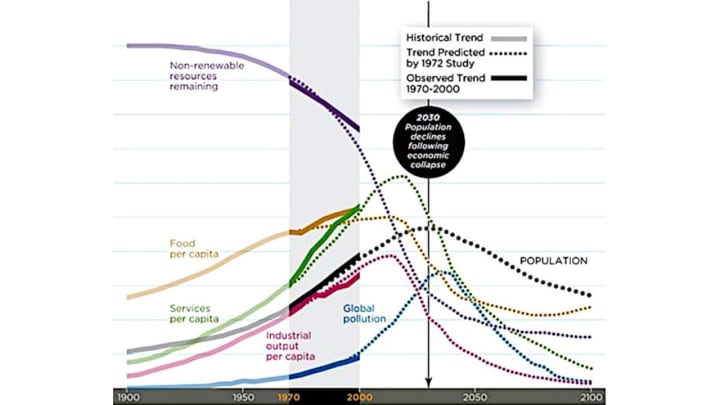
Naturally, no study is flawless. The population may start to decline before 2030, or it may not start to decline until well after 2030. However, it appears certain that it will collapse in the coming decades, if we keep on "business as usual."
About the Creator
Richelle Gerner, Rootbound Homestead
Rootbound Homestead is a community bound by roots. Leaving our old comfy life in FL to move to NY to start living cleaner, more simply, and with purpose. Garden hacks, tips and tricks, natural medicine, healing, animals, recipes and more!






Comments
There are no comments for this story
Be the first to respond and start the conversation.